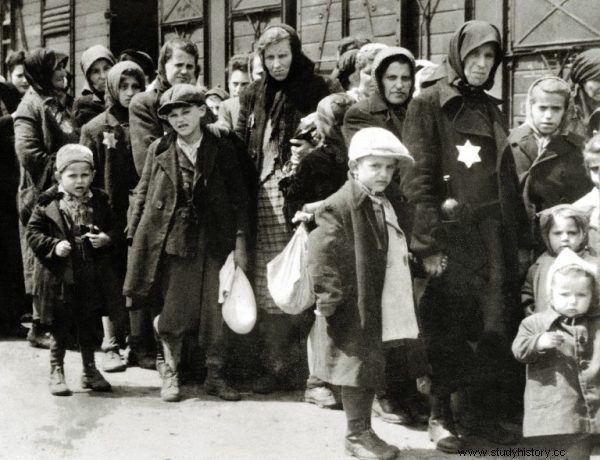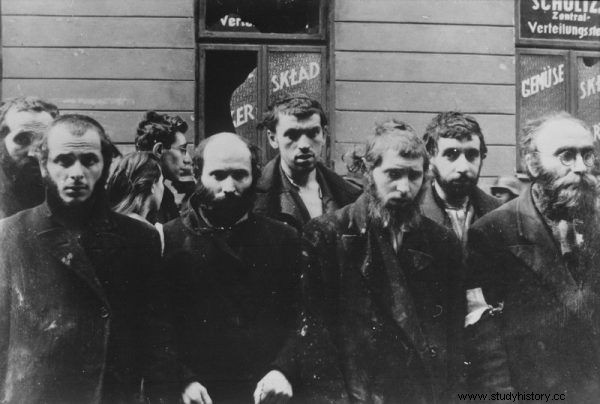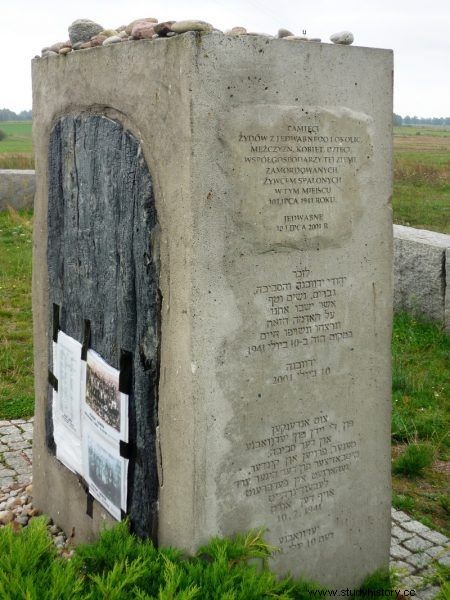They raped, murdered, pulled out golden teeth, smashed little children's heads against walls. These are not the crimes of the Nazis, not the work of the Bolsheviks, not the UPA raid. It was Poles who cracked down on their Jewish neighbors at the turn of June and July 1941. The Germans did not even have to supervise them. Not especially encouraging.
Neighborly pogroms are - generally speaking - spontaneous attacks by local people on local Jews, only partially "managed" by the Nazis. They were often held in areas from which the Red Army withdrew, just before or immediately after the German troops entered.
According to the order of Reinhard Heydrich, in the first phase of the German-Soviet war, the army was to focus on anti-Jewish - or more broadly - anti-Bolshevik propaganda. The idea was to let the myth of the Jew-Bolshevik, Stalin's ally, become embedded in the collective consciousness . The Germans predicted that the Poles would "take care" of their Jewish neighbors on their own. As it turned out, the assumption was correct.
Goniądz
Today I don't have time, I have to finish with the Jews / Bernard K.
The Nazis entered Goniądz on June 27, 1941. The provisional management of the city was left in the hands of the city council formed a few days earlier. The Poles decided almost immediately to count the Jewish population. On July 4, after the arrival of several German officers, everyone was gathered in the market square. The city council identified 30 Jews accused of collaborating with the Red Army.

It was here, in the Jewish cemetery in Goniądz, where local Jews suspected of having Bolshevik sympathies were murdered. Today, only a few overturned matzevot remain from the former cemetery (source:public domain)
After being brutally beaten, they were sent to a makeshift prison in the basement of a local shop. The rest of the Jewish men were divided into "workers' brigades" and locked in a barn. They were to be a workforce for the local peasants. The "Bolsheviks", on the other hand, were murdered in a nearby Jewish cemetery.
According to the testimonies of witnesses, they were killed with metal rods and thrown half-alive into a previously dug hole. The next two weeks were spent in countless homicides, looting and rapes. The Poles who committed them acted without the supervision of German troops.
The actual pogrom took place immediately after the Nazis' decision to create a ghetto. On the night of July 21-22, 1941, the Polish civic guard murdered over 20 Jews, many more were tortured. Even the youngest Jewish women were raped. Several people were buried alive with the massacred bodies of the victims in the cemetery for choleric people, the so-called "choleric hill".
You can read about the crimes of the Holocaust in the book “Black Earth. The Holocaust as a warning ”
The cruelty of the Poles is best evidenced by the fact that the local Judenrat turned to the Germans stationed in the nearby Osowiec for help and protection from the inhabitants of the town. The commander of the Osowiec fort that arrived sentenced to death 17 out of 70 accused Poles . Not for murdering Jews, but for stealing their property which was formally owned by the Third Reich. The number of victims from Goniądz is estimated today at 217 people.
Wasosz
(...) I remember that on Sunday evening I saw Antoni S. from Wąsosz kill two underage girls with a spade and beating the head (...) / Stanisław D.
With the entry of the German troops in Wąsosz, the Polish police were formed, which took over the supervision of the city. The Germans limited themselves to standard propaganda activities and setting fire to the synagogue, and then left the town.

Not a drunk mob, and the local elite murdered Jewish men, women and children in Wąsosz. In the photo:Jews deported to Auschwitz (source:public domain)
The pogrom that took place on July 5, 1941 was carefully planned. The torturers obtained special tools in advance (forged clubs, springs with weights). They chose an anti-tank ditch dug by the Red Army for the burial site. They also took care of the right amount of slaked lime so that did not spread the plague . To avoid escapes, the city was surrounded by special civilian brigades.
Contrary to popular opinion, the murders were not made by the fat dazed with vodka. They were prominent and educated citizens, people driven by "patriotism", often members of the National Party . People were appointed in advance to be responsible for the various stages of the extermination:luring Jews out of their homes, driving them to a ditch, transporting the bodies.
Dantesque scenes emerge from the testimonies of witnesses - smashing children's heads against walls, cutting off fingers with rings, rapes, knocking out golden teeth, tearing out tongues . The liquidation action lasted 3 days. After the culminating night, murdering in the streets was avoided, and the captured Jews were led to the ditch to be executed there. Headshots weren't always effective. The corpses were buried together with the living people. 250 Jews died in the pogrom, although some reports even mention 1,200 victims.

The goal of anti-Semitic propaganda was to dehumanize Jews (source:public domain)
Rajgród
(...) when the Jews were lying on the ground, B. Feliks took his bayonet and stabbed each Jew under his left shoulder blade one by one, and those who were with him were they cut open the heads of Jews with shovels and threw them into the trench. / Czesław K.
The Polish civic guard also exercised power in Rajgród - basically from June to September 1941. The Germans appeared there only a few times to check the progress in "revitalizing" the city . As in Wąsosz, the initiative in "dealing with the Bolshevik-Jewish enemy" was taken over by the city's cultural and intellectual elite. Attacks on Jews began immediately after the Red Army withdrew, although initially they were chaotic.
They were murdered at night. Several bodies lay on the streets of Rajgrod every morning. At the end of June, the Germans appeared in the town and ordered a group of Jews in the market square. It was taken care of by members of the guards and bystanders.

On the day of the pogrom in Rajgród, all Jews were herded to the town square. Poles were to wear Christian medallions to avoid "misunderstandings". The photo shows Jews from the Warsaw ghetto (source:public domain).
The pogrom has begun. Poles were to wear Christian medallions that day to make it easier to distinguish them from the Jews . The course of this "operation" did not differ from the others - there are reports of those tortured, flooded in a nearby lake, beaten with rails and truncheons. Then the Jews were dismantled, lined up in fours and ordered to pass through the whole town in a column headed by a Jewish woman with a red banner in her hands.
Those who attempted to escape were captured and led to a nearby forest, known as the "Rajgrodzki Christmas trees". There they were divided into groups and shot. A group of 40 people escorted 50 townspeople . Polish volunteers finished off those victims who were "only unskillfully" shot with shovels. One Jew was also buried half in the ground to "watch over the rest."
One of the key figures in the anti-Jewish events in Rajgród, teacher Antoni L., wrote in his memoirs that "all this killing tormented him mentally". To calm down he went to house parties executions and conducted scholarly disputes with the local parish priest . The number of Jewish inhabitants of Rajgrod killed that day is estimated at 40-60 people, depending on the accounts.

Neighborly pogroms happened not only in Jedwabne. The photo shows a monument with the inscription:"In memory of the Jews from Jedwabne and its vicinity, men, women and children, co-owners of this land, murdered alive in this place in July 1941" (author:Fczarnowski, license:CC BY-SA 3.0 )
Many of the pogroms carried out in Poland are still covered with a veil of silence. At every step, there are people who deny or at least reduce the scale of these crimes. Why is this happening? There are many reasons. A psychological barrier against admitting that some Poles approved or even implemented the anti-Jewish policy of the Nazis. Shame. Reluctance to hold the perpetrators accountable.
Only a percentage of Poles accused of crimes against Jews were convicted, and the sentences were mostly symbolic. There were also significantly fewer convictions than acquittals. The courts were in no hurry to admit that not only the Germans were the executioners of the Jews in Poland .
The quotes used in the text come from the files of the IPN investigations, quoted by Mirosław Tryczyk in the book "Cities of Death".
You can read about the crimes of the Holocaust in the book "Black Earth. The Holocaust as a warning ”
